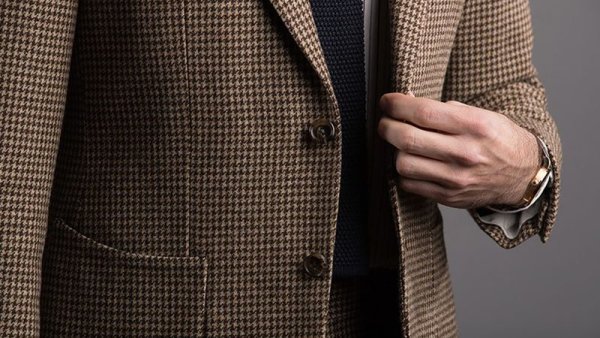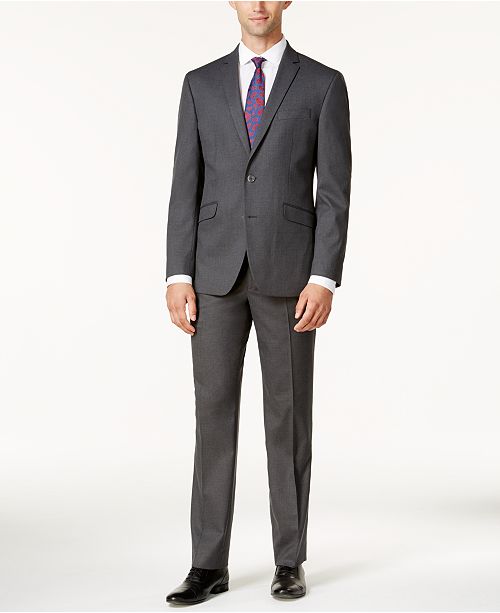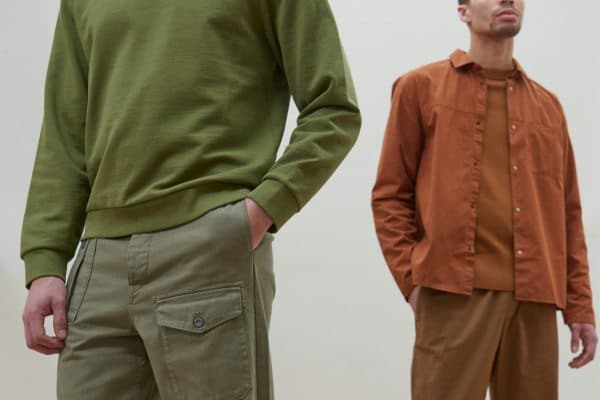Suit Styles Details And How To Tell Them Apart
Suit Styles Details And How To Tell Them Apart
Whether you’re a businessman, a gym junkie, or somewhere in between, a suit is a must-have in every man’s wardrobe. It works surprisingly well for many occasions, including those that are casual. So, if you’re looking to achieve an effortlessly refined appearance, a suit can be the ultimate choice. Of course, to nail this smart and sophisticated look, there are a variety of factors to consider, including cut, color, style, and details. Luckily, our guide will teach you all there is to know about men’s suit styles and details.
The Three Main Suit Styles

Most experts agree that there are historically three major styles of suit; named for the countries in which they originated; though it is now quite common to find all three styles in any country as well as fusions of elements from one or more different styles.
The first is the English style, typified by soft, unpadded shoulders, a long, hourglass body with a high waist; either double or single-breasted, with two or three buttons and side vents. British suits tend to be sympathetic to any body type. The military-inspired cut makes men look lean, muscular, and regal.
The next is the Italian or sometimes called Continental style; epitomized by a lightweight construction, squared & high shoulders; a short close-fitting single-breasted body, with two buttons and no vent. Italian suits work better for any man who’s small-framed, as many Italian men are. Short, thin guys are well-served by the characteristically short jacket and high buttoning stance of Italian suits, and thin men look sharper in their slimmer fit.
Rounding out the group is the American Sack Suit; a natural-shoulder suit with a straight and somewhat roomier body, two or three buttons, and a back vent. American suits recognized by their historically boxy and looser fit. Therefore, heavyset men may feel more comfortable in them as their straight lines can hang more neatly on their bodies.
Today you would be hard-pressed to find a tailor who hasn’t been influenced by all three styles. And most suits take only a few of the distinctive elements from one style or the other.
Bespoke suits and Made to Measure Suits
Suit jackets are defined by many things: the fabric from which they are made (including its color and weight); the style or cut of the suit; the details or trimming applied; and the degree of customization to its wearer, etc. Of these, the cut, or more precisely the suit fit, is paramount – a poorly fitting suit will never look right on the wearer, regardless of the quality or detail.
The cut of a suit is a product of two elements: the overall silhouette and the particular proportions of the man who will be wearing it.
A good tailor will cut a suit to flatter the wearer’s strengths and hide his weaknesses. For this reason alone a man should consider custom clothing; with a suit covering 90% of your body the message it sends more often than not trumps anything that may come from your mouth.
Assuming equality of cut, a custom-made or bespoke suit will flatter more than a made-to-measure suit; which in turn will have a better fit than an off-the-rack suit.
Bespoke suits are custom-tailored to a gentleman’s measurements and built by hand by a master tailor; a custom pattern is created for each man; kept on record and pulled out only when small alterations or new garments are made.
Made-to-measure suits are off-the-rack suits that have been fitted and altered to the wearer’s frame; made from a combination of various pre-built parts.
Suit Fabric
After cutting and customization, the fabric is the next consideration. While the difference in quality between an off-the-rack and bespoke suit is imminently obvious, both can appear quite stylish; that is not the case with poor-quality fabric, which can make even the most expensive custom suit appear cheap.
The most traditional suit fabric is wool; Suits, also available in silk, cotton, gabardine, as well as linen; a traditional favorite not without its own unique challenges – and even mohair and cashmere. There is also the tweed suit, a rugged classic best suited to weekends in the country or more casual affairs; its thick, coarse fabric is designed to repel wind and water in inclement weather.
Suiting Styles
Single Breasted Suit

For the modern-day man looking to invest in a tailored suit, a single-breasted style is perfect for you. A more versatile option, this design is common, functional, and appropriate for a variety of occasions. A single-breasted style refers to a jacket, coat, or blazer that has one row of buttons and a narrow overlap of fabric. Additionally, they usually have a notch lapel. The ultimate in understated elegance, the single-breasted suit is great for elongating the torso, creating a taller and slimmer appearance.
RELATED: How To Wear A Pinstripe Suit With Style
Double Breasted Suit

A double-breasted suit typically has between three to four buttons on either side of the jacket. Additionally, this design has a peak lapel, which works to make your chest appear wider. A sophisticated cut, the double-breasted is ideal for slimmer men. Available in a variety of styles and fits, a double-breasted suit is a must-have in your wardrobe for semi-formal and business events.
Unstructured Blazer

For the laid-back man looking for something a bit more casual and comfortable, you need an unstructured blazer. Best matched with jeans or chinos, this style is typically lightweight and roomy enough to fit additional layers of clothing underneath. The refined piece molds to your body shape, allowing it to drape more naturally and give you a relaxed fit. Above all, the unstructured blazer is a great choice all year round.
Half Canvas

If you’re looking for a suit on a budget, then a half-canvas design is the way to go. This style features a sewn-in canvas piece in the chest and lapel of the jacket and is fused down the bottom. This makes the half-canvas more breathable, comfortable, and long-lasting as compared to a glued interlining. A half-canvas design is also much more affordable than other styles.
Full Canvas

For the best quality you can buy in a suit, you need a full canvas design. The full canvas allows the fabric to sit properly, resulting in a perfectly molded fit over time. It is the most long-lasting design on the market but is generally more expensive than other styles. The full canvas offers the ultimate flexibility, meaning when you move, the suit moves with you.
Suit Silhouette
The term silhouette here refers to the shape or cut of a suit jacket. The shape of a garment sets the tone of your appearance. There are three basic silhouettes on a suit jacket:

Sack or Brooks Brothers Suit Jacket
As the name suggests, it is a shapeless jacket with narrow shoulders. The jacket hangs on the body – presenting a classic shape for anyone wanting to blend into the crowd as it hides the shape of the wearer.
Structured Silhouette Suit Jacket
Influenced by the military uniform – this is the most formal silhouette for a suit jacket. The shoulders are padded and the waist is trim giving the wearer an almost hourglass appearance.
Fitted Silhouette Suit Jacket
This silhouette suits men who are in shape. It presents a tailored fit. With minimal padding, the posture is enhanced by the use of high armholes.
Suiting Details
Notch Lapel

The notch lapel is the most common style of lapel you can get. It is defined by a notch where the jacket collar meets the lapel. It is often found on single-breasted suit jackets, coats, and blazers; traditional yet contemporary and looks stylish on all body types.
Shawl Lapel

Characterized by a rounded edge, the shawl lapel is most commonly seen on dinner jackets and tuxedos. It is the least common type of lapel, and best suited to more formal occasions such as black tie events or weddings.
RELATED: How To Wear A Pinstripe Suit With Style
Peak Lapel

If you’re after a jacket that is a little more formal, you need one with a peak lapel. This type of lapel tends to look a little more fashion-forward than other varieties. It is also the most expensive type of suit lapel. The peak lapel creates an elongating effect by shifting the eyes up toward the shoulders. This makes the style perfect for those looking to add some extra height.
Centre Vent Suit Styles

A center vent is a simple option, making it perfect for men on the slimmer side. It is one of the more affordable designs on the market, and it’s also one of the most popular. Tailored well to the body, this style will have you feeling confident and stylish. The only downside to the center vent is it doesn’t allow for a whole lot of movement.
Side Vent

The crown jewel of vents is the double or side-vented jacket marked by two vents, one on either side, generally just behind the trouser pockets; to provide easy access and freedom of movement.
For the modern man that oozes style, the side vent is the perfect option. This type of vent suits most men as it creates a long, streamlined look. What’s more, they give greater shape through the midsection of the jacket while still allowing flexibility below the waist. This also means less bunching when you sit down, which some men find more comfortable. The only real downside to the side vent is that it’s the most expensive type to manufacture.
No Vent Suit Style

A jacket with no vents is made for slender or shorter guys as it is very well-fitted. It works to hug the torso, and it creates a slimmer look, thus more suitable for special occasions. The downside to the no-vent style is the lack of room for movement, which leads to a less comfortable fit. It is, therefore, best suited to petite, fashion-conscious men who don’t mind sacrificing a bit of comfort for style. This style also works well for athletically built men, but larger men had best avoid it.
RELATED: How To Wear A Three Piece Suit With Style
Suits Pockets
Patch Pocket

Versatile and stylish, the patch pocket can be characterized as a pocket that is sewn on the outside of the jacket. Jackets with patch pockets create a stylish appearance, without looking too overdressed as you would with a suit or a blazer.
Welt Pocket

A welt pocket typically involves a pocket that is attached to the inside of a lined jacket. It has a rectangular opening with one or two flaps. It’s the most formal type of pocket, often featured on eveningwear. Welt pockets look great on any jacket, coat, or blazer, especially when you’re going for a polished appearance.
Jet Pocket

While patch pockets are a more casual option, the jet pocket is a little more formal. They are also the most common type of pocket, which is sewn on the inside of the jacket. Because the pocket is almost entirely internal, the jetted style is a great option for your more formal suit jackets. By keeping the pocket on the inside, the lines of the jacket appear more polished and sleek.
What Color Suit You Should Buy
An important question to answer as we want to maximize your spending power – the worse thing when buying suits is to purchase one you love but can rarely wear as it’s not versatile or appropriate for situations. When it comes to suits and colors, some suit colors simply more useful and versatile compared to others.
Here suit colors start with the most useful and versatile so that it is easier for the man on a budget to prioritize.
Navy Blue Suit

The number 1 and 2 rankings of suit color in this list may be interchangeable especially in North America. However, navy blue edges out charcoal grey by a little as, throughout the United States, navy blue considered the de facto color. A Navy suit ideal for the man who wants to fit in. He wants to be recognized for the effort that he puts in and not necessarily for what he puts on. Another advantage to a navy suit is that if a gentleman wants to get it customized he can include a few fashion-forward details because the color so simple and straightforward.
Charcoal Grey Suit

A charcoal grey suit is just about as versatile as navy. The one advantage that it has over the former is that it is ideal for the younger man as it can add a little more age to him. Navy suits can make a young man look even younger while charcoal grey does not have that same effect. Charcoal grey is extremely easy to match. As that charcoal is firmly on the grayscale (absent of color – a neutral) it goes well with a wide range of colors allowing a man to be more adventurous with the shirts and ties that he pairs grey suit with. When it comes to formality – this is adequate for work, church, weddings, funerals, or meeting the president.
Medium Grey

There are many shades of grey which means that there is a marked difference between charcoal grey and medium grey. A medium grey suit will be a little lighter compared to charcoal. In terms of versatility, it is still about equal to Cambridge grey. However, it is not as formal as charcoal grey and navy blue although very few people and places will be able to tell the difference.
Having the three suits mentioned above will already make for an extremely versatile wardrobe; especially if each suit had slight differences in the details that go into them.
Light Grey Men’s Suit

A light grey suit distinctively lighter compared to its other grey brethren. This suit works well for spring, summer, and fall dressing. The light grey suit is more casual. It is ideal to invest in one once a man has all of the “must-haves” in his wardrobe. This shade is a great way to break up the monotony of wearing the more usual shades. The lighter the shade the easier it is to introduce pattern-such as checks or herringbone into the suit as the patterns are easily more visible.
Black Men’s Suit

The black suit only gets 5th place because compared to the ones previously mentioned not as versatile. Black does not work for every skin type. A black suit works well for a man with a darker complexion and dark hair. A black suit does not look flattering on a man with a lighter complexion and light hair- such as a redhead as it can easily wash him out. Black suits limited in their versatility due to the stark contrast with anything else you are wearing. It is useful for the most formal of occasions such as a black-tie event. If you’re going to an event that requires a tuxedo or a black-tie dress code make sure that your suit is truly black.
Dark Brown Men’s Suit

A dark brown suit can work if a man has dark hair and a darker complexion. It can work for some blonds, redheads, and men with ruddier complexions. A dark brown suit can be effective in adding a little bit of color. However, those who choose to wear it should exert caution as it is clearly not a formal suit. Never wear a dark brown suit to a formal event or to a place where business dressing is taken very seriously (world cities such as New York and London).
Tan/ Khaki Suit

A tan suit falls under the category of a brown suit as they fall within the same color family. However – for this article, I separate them as for summer wear they are more at home in warmer weather and could easily supplant the brown suit in this list due to their versatility assuming you have the weather and complexion to pull it off. Like the light gray suit khaki suit, one can spice up the wardrobe, especially for the man who constantly wears suits to work. They are a solid choice for low-contrast men as the lack of color won’t overpower neutral features and allow you to wear pastels to more effect.
RELATED: Tonal Dressing Complete Men Style Guide
True Blue Men’s Suits

Compared to the navy, a true blue suit can be harder to find. The jacket to the left is an example – please note it is being worn as a sports jacket hence the non-matching trousers. Public personalities & politicians such as Prince William, Prince Harry, and Vladimir Putin have popularized the hue and it is actually a good color to wear. A true blue suit is more popular in Europe and parts of Asia. However, it doesn’t score very high for North American-based gentlemen; because it is simply difficult to find and less formal than the Navy.
A man may have to consider getting a custom suit made if he wants a true blue one. Blue suit a great option if you own close to a dozen suits and want something for weekends or events a formal color not required.






